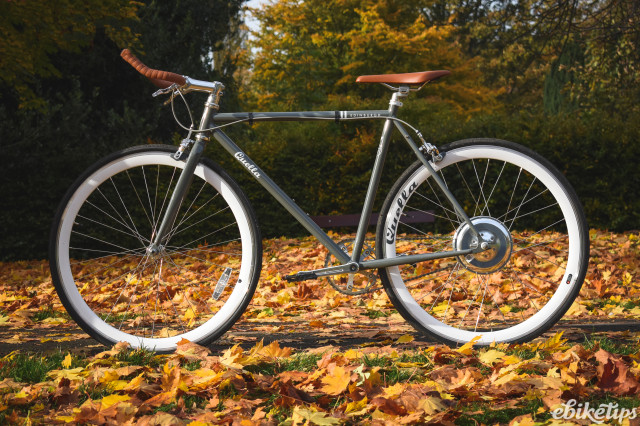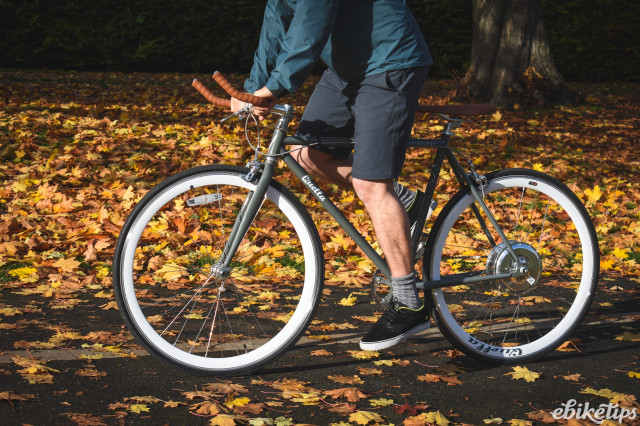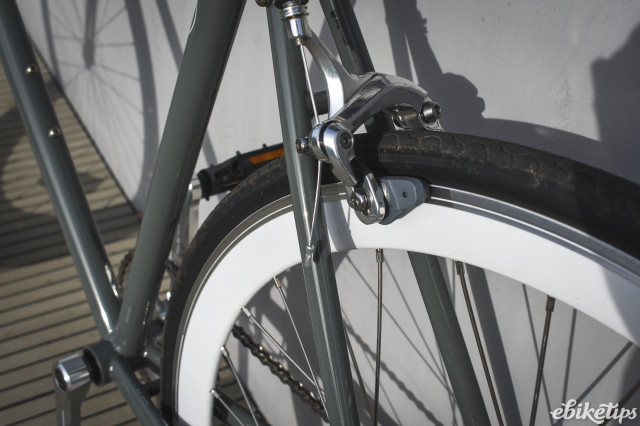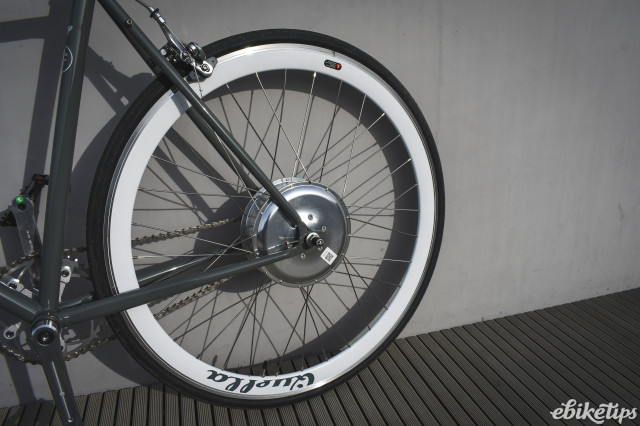Quella Electric Varsity - Edinburgh

Overview
- Simple to use and maintain
- Lightweight
- Fun and fast to ride
- Battery not removable
- Motor power not the strongest
Quella are a UK-based retro-styled, single-speed success story. Starting out in a workshop in 2012 they have progressed via what they describe as ‘renovated chicken coop’ premises to a much larger modern premises. They now have three ranges, the non-electric Nero (with high tensile steel frames), Varsity (cromoly frames) and the Electric range, the latter all based on the Varsity and all using the Zehus hub motor system. They have also collaborated with high profile names like Ted Baker to produce custom builds with copper plating becoming something of a speciality.
Bike Spec
Like all the non-electric Varsity collection, the electric version features a cromoly 4130 frame and track forks – in essence that means a light, fast but affordable design. Components across the Varsity range are the same, featuring Quella’s own brand 700c deep section double wall rims, dual pivot brakes, 25mm wide Kenda tyres, bullhorn style bars and a lovely looking retro-style alloy chainwheel. Wheels rims, bar tape and tyres vary in colour across the Varsity range – my test bike was the Edinburgh variant in understated grey with natty white detailing.
Despite well-made budget choices in keeping with the bike’s very reasonable price (for an e-bike) all components look well-made and there are all sealed cartridge bearings in the headset, bottom bracket and wheels, so, in keeping with the single-speed design, this should be a low maintenance setup. My only change would be softer brake blocks for a tad more stopping power from the dual pivot brakes.
As the accent is on minimalism there are no mudguards or pannier rack though there are threaded attachment points by the front and rear dropouts and ones at the top of the seat stays meaning full length mudguards and rear rack could be fitted. There are also braze ons for a bottle cage on the down tube. You could squeeze in slightly wider tyres if you felt the need but it would probably be a push to fit them alongside mudguards. In other words, you could easily adapt this bike to be a fast commuter style machine.
Zehus
We’ve looked at the Zehus hub motor system before in our review of the remarkable but very expensive Hummingbird. It’s a so-called ‘all in one’ hub system, meaning the gearless motor, 155Wh battery and control electronics are all skilfully enclosed in the large shiny alloy rear hub shell. Unfortunately the battery is not removable but charging is cleverly achieved by unscrewing the driveside axle cap which reveals a charging point.
Power settings are changed via either a smartphone app or a bluetooth linked wireless handlebar button control. Though not vital, it’s useful to have your smartphone on the bars to have the neat app to hand and to keep an eye on battery level.
The Zehus has clears strengths and weaknesses.
It suits this lightweight type of bike as it adds only around 3kg, giving a total bike weight of around 14kg by our scales - very good indeed for an electric. It’s also easy to convert the bike into a non-powered machine too if you have a spare rear wheel. Downsides are relatively weak hillclimbing from the gearless system (geared motors are usually better hillclimbers) and limited range from the small battery.
Ride and Motor Performance
The motor kicks in after around half a turn of the cranks – assuming you have remembered to activate it by gaining a little speed and turning the pedals backward three times (you only need to do this once at the very start of the ride). The Zehus doesn’t provide much help at low speeds, meaning hill starts are an especial challenge with a single speed of 72 gear inches. This is exacerbated even further by the fact it’s gearless – this design of motor is inherently poorer and less efficient than their geared cousins.
If you can live with this slow starting characteristic (and if you ride single speeds you’ll have accepted it as part and parcel of riding), you will find the electric assistance becomes a revelation once up to a few mph under your own steam.
The assist comes in gentle waves and keeps coming as long as you turn the pedals. In contrast to other gearless motors there is some audible noise but its best described as a quiet, wavering, low pitch humming and only noticeable if there is very little or no background noise.
The sporty, leant forward ride position helped me maintain a speed of around 17mph over rolling terrain though hit a prolonged, steeper hill and it’s a choice of letting your speed drop to around 10mph with the motor nudging you up in its highest power setting or getting out of the saddle and doing a bit more serious legwork. Not a problem for the odd very steep hill but in seriously and continuously steep terrain you will need real sustained leg power to get anything like a half decent return from the small battery.
It’s a movement sensing system meaning you don’t quite get the smoothest of smooth power delivery you do with some of the latest mid-drive systems for example, but it still delivers pretty smooth power when up to speed, even though assistance comes in and out with a very small jolt at lower speeds.
As it’s a gearless motor it also features regenerative braking that kicks in when back pedalling. The braking effect is pretty subtle but it may be all that is needed to slow your approach to some junctions before pedalling on. It’s not going to add much power back into the battery but I found it a nice feature to have just for the pleasure of using it.
Quella quote a range of ‘up to 60km’ (37 miles) – possibly feasible if you are really careful with the power and are on easygoing terrain but, on my observation of the app’s % capacity remaining battery indicator, ridden in higher power levels you may only achieve half of this.
Connectivity
If not connected to either Zehus’s own smartphone app or the small wireless control button that comes with the system (or both) the motor will only work in the lowest ‘Eco’ power setting. I couldn’t initially link my phone to the bike but a call to Quella established the bike just needed to be registered with them so that the app could recognise it.
With my phone mounted on the bars it was fairly easy to select which of the three power levels I wanted – or to turn the power off altogether for sustained sessions of flat or downhill riding. Much easier though than trying to tap my phone screen in just the right place, was to use the wireless switch to flick between power levels.
This switch looks to be a recent arrival as it was lacking on our Zehus-powered Hummingbird we tried a while back and it’s a really positive addition. The only downside was that none of the indicative lights on it, meant to show things like how much power was being applied, appeared to work. No matter, as the up and down buttons, allowing changing of power levels, worked every time; of course changing power levels quickly and easily is critical if you want to get good battery range, especially from such a small battery.
The app remained useful though, and I ended up leaving the phone on the bike for the attractive way it gave extra information. For example the amount of assistance or regen level is shown by the size of of the expanding and contracting colour ring around the edge of the centrally placed speedo. The app also lets you customise one of the three power levels between the very subtle eco and the pretty effective turbo. This is great for setting some kind of middling power to suit your terrain, so that you don’t automatically need to go to battery draining turbo every time you hit something more than a small hill.
I lost the wireless link to the app once or twice over several hours riding but on one of those occasions turning bluetooth off and on again cured the problem and on the other occasion it came back spontaneously. Of course many bluetooth devices get these problems and the frequency itself is inherently prone to interference – but the problems weren’t so great they stopped my enjoyment of long rides.
To Conclude...
Despite the weaknesses of the system on paper and the real world gripes I’ve outlined above, this is a sporty, fun to ride e-bike, especially if you don’t mind a bit more human input up steeper hills than you’d normally need to provide on an e-bike. And of course it has huge positives in its simplicity to use and maintain and its impressively low weight. And electric power does suit single speed bikes adding an extra layer of hill climbing ability.
I would see the typical user of a Quella Electric as being an all-year-round commuter in a moderately hilly city who lived in a flat where they needed to carry the bike up stairs to store it. If that was me, the attractive price tag would certainly put it near the top of my list.
It’s good to see Zehus have developed a wireless control button which certainly is a step in the right direction for their extremely neat and clever system. However, a geared motor version with a removable battery (which you could then swap out for spare you are carrying on your ride) that also featured a few derailleur gears and bigger capacity battery cells would have the potential to take the e-bike world by storm….













